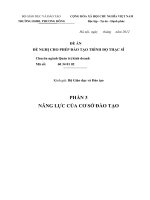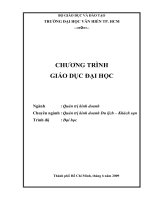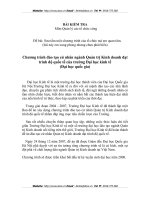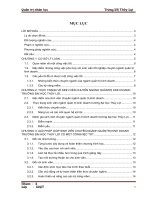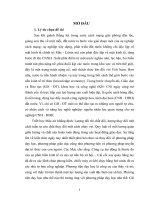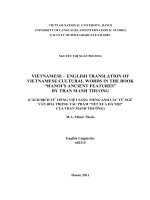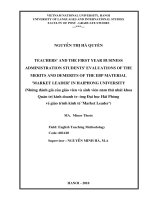hiết kế chương trình đọc tiếng Anh chuyên ngành cho sinh viên năm thứ 2 ngành Quản trị kinh doanh Trường Cao đẳng nghề Giao thông vận tải Đường thuỷ 1
Bạn đang xem bản rút gọn của tài liệu. Xem và tải ngay bản đầy đủ của tài liệu tại đây (1.2 MB, 66 trang )
VIETNAM NATIONAL UNIVERSITY, HANOI
UNIVERSITY OF LANGUAGES AND INTERNATIONAL STUDIES
FACULTY OF POST-GRADUATE STUDIES
NGUYỄN THỊ XUÂN PHƯƠNG
VIETNAMESE – ENGLISH TRANSLATION OF
VIETNAMESE CULTURAL WORDS IN THE BOOK
“HANOI’S ANCIENT FEATURES”
BY TRAN MANH THUONG
(CÁCH DỊCH TỪ TIẾNG VIỆT SANG TIẾNG ANH CÁC TỪ NGỮ
VĂN HÓA TRONG TÁC PHẨM “NÉT XƯA HÀ NỘI”
CỦA TRẦN MẠNH THƯỜNG)
M.A. Minor Thesis
English Linguistics
602215
Hanoi, 2011
VIETNAM NATIONAL UNIVERSITY, HANOI
UNIVERSITY OF LANGUAGES AND INTERNATIONAL STUDIES
FACULTY OF POST-GRADUATE STUDIES
NGUYỄN THỊ XUÂN PHƯƠNG
VIETNAMESE – ENGLISH TRANSLATION OF
VIETNAMESE CULTURAL WORDS IN THE BOOK
“HANOI’S ANCIENT FEATURES”
BY TRAN MANH THUONG
(CÁCH DỊCH TỪ TIẾNG VIỆT SANG TIẾNG ANH CÁC TỪ NGỮ
VĂN HÓA TRONG TÁC PHẨM “NÉT XƯA HÀ NỘI”
CỦA TRẦN MẠNH THƯỜNG)
M.A. Minor Thesis
Field: English Linguistics
Code: 602215
Supervisor: Assoc. Prof. Dr. Lê Hùng Tiến
Hanoi, 2011
TABLE OF CONTENTS
Declaration
Acknowledgement
Abstract
Table of contents
PART A: INTRODUCTION
1. Rationale 1
2. Scope of the study 2
3. Aims of the study 2
4. Methodology 2
5. Design of the study 3
PART B: DEVELOPMENT
CHAPTER 1: THEORETICAL BACKGROUND
1.1. Translation Theory 5
1.1.1. Definition of translation 5
1.1.2. Translation equivalence 6
1.1.2.1. The concept of translation equivalence 6
1.1.2.2. Types of equivalence in translation 8
1.1.3. The problem of non – equivalence 10
1.2. The concept of culture in translation 13
1.3. Cultural categories 14
1.4. Translation methods 15
CHAPTER 2: THE MOST COMMON TYPE OF CULTURAL WORDS
EQUIVALENCE
2.1. The most common types of cultural words 18
2.2. The most common types of equivalence 18
2.3. Strategies to deal with nil – equivalence 21
2.3.1. Borrowings 22
2.3.2. Paraphrasing 24
2.3.2.1. Description of the ingredients and how the dish is cooked 24
2.3.2.2. Description of the use of the object 24
2.3.2.3. Description of the shape and appearance of things 25
2.3.2.4. Literal translation 26
2.3.2.5. Transferring meanings of the words 27
CHAPTER 3: OTHER TYPES OF EQUIVALENCE
3.1. Many-to-one equivalence 29
3.2. One-to-part-of-one equivalence 32
3.3. One-to-one equivalence 35
3.4. Reasons for the differences 37
3.4.1. Different religions and beliefs 37
3.4.2. Different traditions and customs 38
3.4.3. Different historical allusion 38
PART C: CONCLUSION
1. Addressed issues 39
2. Suggestions for further study 40
REFERENCES
APPENDICES
PART A – INTRODUCTION
1. Rationale
Language is the carrier of the culture. For one thing, language is a part of culture
and plays an important role in it. Thus it reflects culture. For another, as a mirror of
culture, language is strongly influenced and shaped by culture. Culture and
intercultural competence and awareness that rise out of experience of culture, are far
more complex phenomena than it may seem to the translator. The more a translator
is aware of complexities of differences between cultures, the better a translator s/he
will be. It is probably right to say that there has never been a time when the
community of translators was unaware of cultural differences and their significance
for translation. Translation theorists have been cognizant of the problems attendant
upon cultural knowledge and cultural differences at least since ancient Rome.
Cultural knowledge and cultural differences have been a major focus of translator
training and translation theory for as long as either has been in existence. The main
concern has traditionally been with words and phrases that are so heavily and
exclusively grounded in one culture that they are almost impossible to translate into
the terms – verbal or otherwise – of another. Long debate have been held over when
to paraphrase, when to use the nearest local equivalent, when to coin a new word by
translating literally, and when to transcribe. All these “untranslatable” cultural-
bound words and phrases continued to fascinate translators and translation theorists.
As hard as it may seem, the translation of Vietnamese cultural words is now an
inevitable part in our integrating life since we have become a member of WTO. It is
important for any Vietnamese to match cultural equivalence between English and
Vietnamese to introduce our culture into the world. However, not many empirical
studies have been conducted so far on the issue of translation of Vietnamese cultural
words into English. Those reasons may justify for the necessity of this study. The
study investigates how Vietnamese cultural words are transferred in the book
“Hanoi’s Ancient Features”. It also raised the need for translators of Vietnamese-
English texts, especially in treating cultural terms, to pay close attention to the
linguistic and cultural elements of the source texts.
2. Scope of the study
Within limited time, resources, conditions, and the length of the thesis, the
researcher focuses only on cultural words occurring in the book “Hanoi’s Ancient
Features” by Tran Manh Thuong. Such is the boundary set for my thesis so as to
achieve a thorough investigation. Specifically, the study takes into consideration
such major aspects as follows:
The most common types of equivalence
The possible reasons for the non – equivalence
Their translations.
3. Aims of the study
The main aims of the study are:
To work out the most common types of equivalence used in the translation of
Vietnamese cultural words.
To draw out the common problems of equivalence seen in the translation of
Vietnamese cultural words into English.
To draw out strategies and procedures that may apply to the translation of
Vietnamese cultural words and suggest some implications for the translation
of the cultural words.
4. Methodology
4.1. Research questions
The thesis seeks answers for the following research questions:
a. What is the most typical type of equivalence used in the translation of
cultural words in the book “Hanoi’s Ancient Features”?
b. What are the most common problems in translating Vietnamese cultural
words into English that can be seen in the book?
c. What are the common methods used in the translation of Vietnamese cultural
words?
4.2. Research methods
On the completion of the thesis, the researcher went through the following steps:
Building up a theoretical background by reviewing translation and
terminology
Collecting and grouping Vietnamese cultural words in the book and their
English equivalents for description, analysis and induction
Finding out the similarities and differences and draw out the translation used
in the translation of cultural words.
The main method is contrastive analysis.
4.3. Data collection
The Vietnamese cultural words studied are taken from the book “Hanoi’s Ancient
Features” and their equivalents are picked out from the translation by the
Vietnamese translator Tran Manh Thuong.
5. Design of the study
The study consists of three main parts, references and appendices as follows:
PART A – INTRODUCTION
The introduction gives rationale for the study. It also outlines the aims and the
methods of the study.
PART B – DEVELOPMENT
The development comprises two chapters.
Chapter 1: Theoretical background
The theory of translation and the translation of cultural words will be dealt
with in this chapter
Chapter 2: The most common type of equivalence
This chapter features an investigation into the equivalence between
Vietnamese and English translation of cultural words to draw out the most
common type of equivalence in translation of Vietnamese cultural words, that
is nil equivalence.
It also studies the translation of Vietnamese cultural words and translation
methods employed in their translation by Tran Manh Thuong in his book
“Hanoi’s Ancient Features”.
Chapter 3: Other types of equivalence
The other types of equivalence are to be stated and analysed in this chapter.
The researcher also indicates the reasons for the differences in cultural words
between the two languages at the last part.
PART C – CONCLUSION
The conclusion summaries the strategies and procedures and methods of translation
as well as makes relevant suggestions.
Reference includes all the books, articles or website that has been referred to during
the writing of this thesis.
The appendices list examples of different groups of equivalence in order of the
alphabet.
PART B – DEVELOPMENT
CHAPTER 1
THEORETICAL BACKGROUND
1.1. Translation Theory
1.1.1. Definition of translation
Kelly, L.G - a prominent figure in linguistics stated “Without translation, there is no
history of the world.” What is a basis for him to make such a strong claim? What is
translation that is of great importance as implied by Kelly? Translation, traditionally
and controversially seen with its status as an art or a science, has been viewed
differently through times and thus defined variously. Thus, in this section, the writer
cites some definitions proposed by Catford, Larson, Newmark and Bell in order to
have a clear concept about translation.
General definition of translation has been set by Catford (1965:20) in “A Linguistic
Theory of Translation”, he defines translation as “the replacement of textual
material in one language (SL) by equivalent textual material in another language
(TL)”. He tried to emphasize the translation is the process of substituting the
equivalent of lexical items ‘textual material’. It means that the process of
substituting a text cannot be regarded as a translation if the message of the TL text
is not comparable to the message of the SL text.
In addition to statement of Catford, Larson (1984:3) views that translation is a
process of how a language is transferred into another by changing the form of
source language and not the meaning of the source language, as he states that:
Translation consists of translating the meaning of the source
language into the receptor language. This is done by going from
the form of the first language to the form of a second language
by way of semantic structure. It is meaning which is being
transferred and must be held constant. Only the form changes.
Larson (1984:3)
In accordance with those definitions, Newmark (1988) assumes that translation is a
way of conveying message from the author of the SL into TL. He points out
translation as “rendering the meaning of a text into another language in the way that
the author intended the text.” (1988:5). He did not seem to totally agree with Larson
– who viewed translation a basic “change of form”, by emphasizing the “intended
the text”.
In line with the theory above, Bell (1991:5) assumes that “translation is the
expression in another language (or target language) of what has been expressed in
another, source language, preserving semantic and stylistic equivalences”. He also
says that translation “is the replacement of a representation of a text in one language
by a representation of an equivalent text in a second language.”
It is noticed that those definitions discussed above, though put different, share
common features which is to find equivalents that best or appropriately preserve
features of the original in terms of semantics, grammatical structures, lexis, cultural
context as well as communication situation among other things to be considered.
1.1.2. Translation equivalence
1.1.2.1. The concept of translation equivalence
Translation equivalence is a principal concept in translation theory. It is a
constitutive feature and the guiding principle of translation. As Catford points out,
"the central problem of translation-practice is that of finding TL equivalents. A
central task of translation theory is that of defining the nature and conditions of
translation equivalence." (Catford 1965:21) Actually, since the fifties of the
twentieth century, many translation theorists have involved and elaborated
translation equivalence in their respective theories. First of all, it is necessary for us
to understand exactly the meaning of the word "equivalence" itself. According to
Mary Snell-Hornby (1988:17), for the last 150 years, the word "equivalence" in
English has been used as a technical term in different kinds of exact sciences to
refer to a number of scientific phenomena or processes. For instance, in
mathematics, it indicates a relationship of absolute equality that involves guaranteed
reversibility. At the same time, however, it can also be used as a common word in
the general vocabulary of English, and, in this sense, it means "of similar
significance". In other words, the word "equivalence" is used in the English
language both as a scientific term and as a common word. As a central concept in
translation theory, "equivalence" cannot be interpreted in its scientific sense. It can
only be understood in its common sense as a general word. As J.R Firth points out
in his writing on translation, it was in the common sense and as an item of the
general language that the word "equivalence" was originally used in English
translation theory.(Snell-Hornby 1988:17)
Philosophically speaking, there are no things that are absolutely identical. Nida
expresses this view as follows:
There are no two stones alike, no flowers the same, and no two
people who are identical. Although the structures of the DNA in
the nucleus of their cells may be the same, such persons
nevertheless differ as the result of certain developmental factors.
No two sounds are ever exactly alike, and even the same person
pronouncing the same words will never utter it in an absolutely
identical manner. (Nida 1986: 60)
As far as languages are concerned, there are no two absolute synonyms within one
language. Quite naturally, no two words in any two languages are completely
identical in meaning. As translation involves at least two languages and since
each language has its own peculiarities in phonology, grammar, vocabulary,
ways of denoting experiences and reflects different cultures, any translation
involves a certain degree of loss or distortion of meaning of the source text. That
is to say, it is impossible to establish absolute identity between the source text and
the target text. Therefore, we can say that equivalence in translation should not be
approached as a search for sameness, but only as a kind of similarity or
approximation, and this naturally indicates that it is possible to establish
equivalence between the source text and the target text on different linguistic levels
and on different degrees.
1.1.2.2. Types of equivalence in translation
Translation has been studied by many scholars from different notions of
view. Some of translation scholars defined their theories a source-oriented theory,
others regarded the target-oriented theories. These theorists have studied
equivalence in relation to the translation process, using a variety of approaches,
namely quantitative and qualitative approach; however, all translation theories
are related to the notion of equivalence in one way or another. Not
surprisingly, equivalence plays a crucial role in translation which is the matter of
establishing equivalence between source language and target language. Some of the
most widely accepted are quantitative, meaning-based, form-based and function-
based.
a. Quantitative approach
Kade (1968) and other writers on lexical equivalence, in particular in the area
of terminology, categorizes equivalence relationships as follows:
One-to-one equivalence: There is a single expression in the TL for a single
expression in the SL.
One-to-many equivalence: There is more than one expression in the TL for
a single SL one.
Many-to-one equivalence: There is more than one expression in the SL, but
there is only a single expression in the TL that is equivalent to them.
One-to-part-of-one equivalence: A TL expression is only equivalent to part
of the concept designated by a single expression in the SL, or the
equivalent in the TL has a broader meaning than the concept in the SL.
Nil equivalence: There is no expression in the TL for a single expression
in the SL
b. Meaning-based equivalence
Under Koller (1979)’s view, there are five types of equivalence:
Denotative equivalence: The SL and the TL words refer to the same thing
in the real world.
Connotative equivalence: This type of equivalence provides additional
values besides denotative value and is achieved by the translator’s choice
of synonymous words or expressions.
Text-normative equivalence: The SL and the TL words are used in the
same or similar context in their respective languages.
Pragmatic equivalence: With readership orientation, the SL and TL words
have the same effect on their respective readers.
Formal equivalence: This type of equivalence produces an analogy of
form in the translation by their exploiting formal possibilities of TL, or
creating new forms in TL.
c. Form-based equivalence
Baker (1992) proposes five levels of equivalence: equivalence at word level,
equivalence above word level, grammatical equivalence, textual equivalence,
pragmatic equivalence. Firstly, equivalence at word level is taken into
consideration. Baker defines the term “word” and notes that word sometimes
have different meanings in different languages, and relates meaning of words
with morpheme. Baker introduces problems at word level and above word level
before suggesting some strategies in dealing with them. Secondly,
grammatical equivalence refers to the diversity of grammatical categories across
languages. She affirms that grammatical rules across languages may differ, which
lead to some problems in finding a direct correspondence in the TL. Thirdly, textual
equivalence refers to the equivalence between a SL text and a TL text regarding
information and cohesion. Whether the cohesive relations between TL and SL
should be maintained depends on three main factors, that is, the target audience, the
purpose of the translation and the text type. Finally, pragmatic equivalence refers to
implication of the TL text. The duty of a translator is recognizing the implied
meaning of SL text, and then reproducing it in a way that readers of the TL can
comprehend clearly without any misunderstanding culturally.
d. Function-based equivalence:
Nida (1964) argues that there are two different types of equivalence,
including formal equivalence- which, in the second edition, is referred to as formal
correspondence and dynamic equivalence. Formal correspondence focuses attention
on both form and content (as in Bible, international diplomacy, law and the like)
unlike dynamic equivalence emphasizes the text readability.
Formal correspondence consists of a TL item which represents the closest
equivalent of a SL word or phrase. Nida stresses that there are not always formal
equivalents between language pairs. Dynamic equivalence is a translation
principle in which a translator translates the meaning of the original text;
producing the same impact on the original wording did upon the ST audience.
Nida (1964) believes that the main aim of equivalent effect is to achieve "the closest
natural equivalent to the source language" (p.126). He stresses that the adaptation of
grammar, cultural references and lexicon of the ST will lead to the translation
naturalness while highlighting the preservation of the text meaning on its style as
the root of the equivalent effects. He argues that formal translators who focus more
on forms are more likely to misinterpret the "intention of the author" and "distort
the meaning" (p. 191-192).
1.1.3. The problem of non-equivalence
The problem of non-equivalence has been drawing the attention of many
researchers. Jakobson claims that "there is ordinarily no full equivalence between
code units" (as cited in Munday, 2001). Jakobson also explains the differences
between structures, terminology, grammar and lexical forms of languages are
the main reasons of non-equivalence. Jacobson states that "equivalence in
difference is the cardinal problem of language and the pivotal concern of
linguistics." (as cited in Munday, 2001). In his theory, the general principle of
cross-language difference and the concept ‘semantic field’ has been established.
Catford (1965) found that there are two factors which affected the equivalence
i.e. linguistic and cultural factors, leading to two kinds of equivalents i.e. linguistic
and cultural equivalents. This finding of Catford is very significant because it
consists of both important approaches toward equivalence, namely, linguistic
and cultural approaches. On the contrary, there were some arguments against
Catford theory. Snell-Hornby (1988:19-20) claims that textual equivalence
introduced by Catford is “circular” and his examples are “isolated and even
absurdly simplistic” . Furthermore, she criticizes equivalence in translation is an
illusion because there are many aspects, including textual, cultural and situational
ones, get involved in the equivalent degree of the translation. House (1977) also
agrees that not only functional but situation factor need to be taken into
consideration during the process of translation.
Equivalent effect, as judged by Newmark (1988:134), is “the desirable result, rather
than the aim of any translation”. Accordingly, the equivalent effect is a result which
all translators long to achieve. Further, Newmark (1988) argues that the text
may reach a 'broad equivalent effect' only if it is 'universal' that means cross
culture share common ideas.
Among many approaches introduced above, Mona Baker was the most outstanding
theorist dramatically focusing on equivalence at word level since, as being claimed
by her, word is the basic unit to be considered in meaning of translation text.
Her analysis on word level is particularly clear, easy to comprehend.
a. Culture-specific concepts
The source-language word may express a concept which is totally unknown in the
target culture. The concept in question may be abstract or concrete; it may relate to
a religious belief, a social custom, or even a type of food.
b. The source-language concept is not lexicalized in the target language
The source-language word may express a concept which is known in the target
culture but simply not lexicalized, that is not ‘allocated’ a target-language word to
express it.
c. The source-language word is semantically complex
The source-language word may be semantically complex. This is a fairly common
problem in translation. Words do not have to be morphologically complex to be
semantically complex (Bolinger and Sears, 1968). In other words, a single word
which consists of a single morpheme can sometimes express a more complex set of
meanings than a whole sentence.
d. The source and target languages make different distinctions in meaning
The target language may make more or fewer distinctions in meaning than the
source language. What one language regards as an important distinction in meaning
another language may not perceive as relevant.
e. The target language lacks a superordinate
The target language may have specific words (hyponyms) but no general word
(superordinate) to head the semantic field. English has no ready equivalent for
facilities, meaning ‘any equipment, building, services, etc. that are provided for a
particular activity or purpose’
f. The target language lacks a specific term (hyponym)
More commonly, languages tend to have general words (superordinates) but lack
specific ones (hyponyms), since each language makes only those distinctions in
meaning which seem relevant to its particular environment.
g. Differences in physical or interpersonal perspective
Physical perspective may be of more importance in one language than it is in
another. Perspective may also include the relationship between participants in the
discourse (tenor).
h. Differences in expressive meaning
There may be a target-language word which has the same propositional meaning as
the source-language word, but it may have a different expressive meaning.
i. Differences in form
There is often no equivalent in the target language for a particular form in the
source text. Certain suffixes and prefixes which convey propositional and other
types of meaning in English often have no direct equivalents in other languages.
j. Differences in frequency and purpose using specific forms
Even when a particular form does have a ready equivalent in the target language,
there may be a difference in the frequency with which it is used or the purpose for
which it is used.
k. The use of loan words in the source text
The use of loan words in the source text poses a special problem in translation.
Quite apart form their respective propositional meaning, loan words such as au fait,
chic, and alfresco in English are often used for their prestige value, because they
can add an air of sophistication to the text or its subject matter.
1.2. The concept of culture in translation
In the Concise Oxford Dictionary (1999), the definition of “culture” varies from
descriptions of the “arts” to plant and bacteria cultivation. However, the translation
scholar, Newmark (1988:94), views culture as “a way of life and its manifestations
that are peculiar to a community that uses a particular language as its means of
expression". Newmark’s (1988) definition implies that culture reflects the way in
which a particular cultural group perceives and interprets meaning. This implication
highlights the fact that different cultural groups do not necessarily attach the same
meaning to reality. Each constructs its own way of expressing its values and beliefs.
Tomaselli (1985), a distinguished scholar on cultural issues in the media, agrees
with this opinion. Tomaselli (1985:8) regards culture as “the process which informs
the way meanings and definitions are socially constructed by social actors
themselves”. Newmark’s and Tomaselli’s views of culture indicate that cultural
differences and similarities between different culture groups need to be taken into
account in order to attain a meaningful understanding of different groups.
In translation the recognition of different cultures is very important because it
facilitates a better understanding of a translation and its original. Therefore,
translation should not only be about transferring messages from one language to
another, but it should also involve transferring certain cultural elements from source
language to target language. This is further confirmed by Lotman’s (1978) theory
which states that “no language can exist unless it is steeped in the context of culture;
and no culture can exist which does not have at its centre, the structure of natural
language”. Bassnet avers that “to attempt to impose the value system of the source
language onto the target language is dangerous ground, and the translator should not
be tempted by the school that pretends to determine the original intentions of the
author on the basis of a self-contained text” (1980:13).
In other words, translation is not simply linguistic transfer. “No two languages are
ever sufficiently similar to be considered as representing the same social reality.
The worlds in which different societies live are distinct worlds, not merely the same
world which different labels attached” (Sapir 1958:69). Therefore, when translating,
it is important to consider not only the lexical impact on the TL reader, but also the
manner in which cultural aspects may be perceived and make translating decisions
accordingly.
1.3. Cultural categories
There exist many different classifications proposed by various authors. Newmark
(1988:95) talks about “cultural categories”, among which cultural words can be
classified:
a. Ecology including flora, fauna, types of winds and natural phenomena, etc.;
b. Material culture, related to the artificial products manufactured by a society,
like food, clothes, housing, cities, means of transport, etc.;
c. Social culture, including work and employment, and leisure;
d. Organizations, political, administrative, religious or artistic concepts,
activities or institutions;
e. Gestures and habits (often described in “non-verbal” language)
Furthermore, there are other authors who introduce new factors and concepts in
their typologies of cultural references, such as Mallafre (1991), who deals with a
related factor: the opposition between tribe language (referring to private life) and
polis language (regarding public life). The first element would be related to the own
personal experience of an individual, and it would allude to his or her personal
relationships, his or her family, etc. In this group, there can be children’s plays,
traditional tales and stories, folk feasts and traditions. In contrast, polis language
would be intimately related to the social, political and working environment of an
individual as a community citizen, and it would refer to laws, conventions, rights,
organizations, etc.
Finally, Katan (1999:45) distinguishes five categories in his classification of
cultural words:
a. Environment.
b. Behaviour
c. Capacities and strategies.
d. Principles
e. Identity
1.4 Translation methods
According to Newmark (1988:45), methods of translation can be presented in the V
diagram as follows:
SL emphasis TL emphasis
Word-for- word translation Adaptation
Literal translation Free translation
Faithful translation Idiomatic translation
Semantic translation Communicative translation
Word-for-word translation
This method focuses on SL word order in which words are translated by most
common meaning and out of context. Therefore, the results of this method are that
the translation is read like original text.
Literal translation
The SL text, concretely its grammatical constructions are converted to their nearest
equivalents. In this method, words are translated single and out of text.
Faithful translation
Where the translator reproduces precise contextual meaning. Here, cultural words
are not translated.
Semantic translation
More account is taken on aesthetic value of the SL text and some small concessions
are made to the readers. As a result, the translation is more flexible and less
dogmatic than the application of other methods in the group
Communicative translation
This method attempts to produce on its readers an effect as close as possible to that
obtained on the readers of the original.
However, according to Peter Newmark (1988), there are only two methods of
translation that are appropriate to any texts. They are as follows.
1) Communicative translation
In this method, translators try to produce the same effect on the TL readers
as the original does on the SL readers
2) Semantic translation
Translators attempt to reproduce the exact contextual meaning of the author
with the constraints of the TL grammatical structures.
Adaptation
This is the ‘freest’ form of translation. It is used mainly for plays (comedies) and
poetry; the themes, characters, plots are usually preserved, the SL culture converted
to the TL culture and the text rewritten. The deplorable practice of having a play or
poem literally translated and then rewritten by an established dramatist or poet has
produced many poor adaptations have ‘rescued’ period plays.
Free translation
Free translation reproduces the matter without the manner, or the content without
the form of the original. Usually it is a paraphrase much longer than the original, a
so-called ‘intralingual translation’, often prolix and pretentious, and not translation
at all.
Idiomatic translation
Idiomatic translation reproduces the ‘message’ of the original but tends to distort
nuances of meaning by preferring colloquialisms and idioms where these do not
exist in the original.
1.5. Chapter conclusion
This part of study has fulfilled its task of gathering information about general
translation theories and cultures. A number of different approaches have been
examined to shed light on the translation of cultural words in the next chapter.
CHAPTER 2
THE MOST COMMON TYPE OF CULTURAL WORDS EQUIVALENCE
2.1. The most common types of cultural words
In the classification of Peter Newmark (1988), there are five major categories of
cultural words including ecology, material culture (artifacts), social culture – work
and leisure, organizations, customs, ideas and gestures and habits.
In Tran Manh Thuong’s book, the frequency of material culture, and physical
cultural objects in particular is the highest in comparison with other types. The
following chart illustrates the ratio among them.
Cultural words
Quantity
Percentage
Physical cultural objects
172
41.3%
Others
244
58.7%
41.30%
58.70%
Physical cultural objects Others
2.2. The most common type of equivalence – Nil equivalence
As mentioned in Chapter 1, there exist many approaches to the classification of
equivalence in translation. However, Munday’s (2001) view of quantitative
equivalence including one-to-one equivalence, many-to-one equivalence, one-to-
part-of-one equivalence and nil equivalence seems to be best suited the aim of this
thesis. We can hardly find the case of one-to-many equivalence, so this is not taken
into account.
The writer of the thesis has listed almost all the cultural words occurred in the book
and put them into the order of the most common types of equivalence to the least
common one. The data can be easily found in the table below:
Type of equivalence
Quantity
Rate (%)
Nil equivalence
211
50.7%
One-to-one equivalence
74
17.8%
Many-to-one equivalence
71
17.1%
One-to-part-of-one
equivalence
60
14.4%
Total
416
100%
50.7%
17.8%
17.1%
14.4%
Nil One-to-one Many-to-one One-to-part-of-one
It can be seen clearly from the chart showing the equivalence in the translation of
“Hanoi’s Ancient Features” that nil equivalence accounts for the largest part of
cultural words translation with 50.7%. This result comes as no surprise to any
translator who have ever involved in the translation of culture related words. The
domination of nil equivalence in translating cultural words can be explained by the
following reasons.
First of all, it is the availability that leads to the biggest share of nil equivalence.
Nida (1986:60) stated “There are no two stones alike, no flowers the same, and no
two people who are identical.” let alone two cultures. It is widely accepted that with
the exactly same meaning, no one can be sure that two cultures could choose to
express it the same way no matter how close the two cultures are. Meanwhile,
English and Vietnamese cultures are widely known to be totally different when the
former represents Western culture and the latter characterizes Eastern. For example,
the Vietnamese would prefer to use the chicken in many idioms “Vắng chúa nhà, gà
vọc niêu tôm”, but English people would like to use “cat” and “mouse” as in “When
the cat is away, the mice will play”. An idiom “Run như cầy sấy” seems to be very
popular with Vietnamese people, but their English equivalent could be “As nervous
as a cat” or “As nervous as a mouse”. This is only the case when two cultures
express the exactly same meaning. Therefore, when coming into the area where
there are abundant of things in source language culture but there is no such things in
target language culture, one can easily see how difficult it is in that situation.
The difficulty presents itself when the Vietnamese word may express a concept
which is mostly unknown in the target language culture. Those words often relate to
many types of cultural objects. For example:
Điếu bát
Lư
Đỉnh
Câu đối
Nón
Bồng
Thư tịch
Nghiên
Sắc phong
The situation may result from geographical differences in the cultures of two
countries. Vietnam locates in Asia with a strong domination of China, the once
powerful empire in the world. Whereas, with the location in the West, English
culture is mainly under the flow of Western culture which, as one can say, is totally
different from the East.
Also due to the location of the country, with favourable natural conditions for
agriculture, Vietnam has been under the strong influence of paddy culture. This may
also the reason for the second group of non-equivalence in the book. Living on land,
Vietnamese peasants also have their own festivals, customs or ceremonies relating
to land, housing and trees with special attention to the living of people. For
instances:
Tết Nguyên Đán
Thờ Thổ Công
Đi hái lộc
Dựng cây nêu
Rằm tháng Tám
Dâng sớ
Lễ Giao thừa
Cấy lúa
Tết Ông Táo
As the peasants, the Vietnamese have to work long hours on the fields to earn their
living. However, it would be a mistake to come to a conclusion that work is their
only living activity. Such a boring life can not be the Vietnamese’s who usually take
any possible chance to organize and take part in various kinds of traditional games
and entertainments, not only in special occasion but also in daily life. The example
can be as follows:
Cờ người
Ca trù
Múa sư tử
Hát quan họ
Bơi chải
Kéo co
Múa võ
Tuồng
Hát trống quân
In the prolonged culture of Vietnam, traditional games and entertainments also play
their part in diversifying the spiritual life of people and in creating distinct ethnical
and regional characteristics.
With the above mentioned groups, we are just roughly at the foot of the mountain of
Vietnamese cultural words which reflect the richness of the source language culture.
This obviously presents a huge challenge to the translator and the writer.
2.3. Strategies to deal with nil-equivalence
The translator’s task is not as simple as one might think. It is unacceptable for him
to omit all words that he finds difficult. So what should the translator do when he
confronts the translation of culture-specific concepts? Digging in the translation of
those nil equivalence words, one can clearly see that the first common translation
tool that is widely used is borrowings.

